Refraction of light refers to when light travels in a single direction, it follows a straight path while when it bends. Reflection and refraction are the main aspects of the light that fall under the ‘ray optics’. Let’s understand the concept of refraction of light and its related components through this blog.
This Blog Includes:
- What is Refraction of Light?
- Key Features of Refraction
- Laws of Refraction of Light
- What is Snell’s Law?
- Change of Speed Causes Change of Direction
- Refractive Index of Transparent Substances
- Types of Refraction
- Effects & Examples of Refraction
- Applications of Refraction of Light
- Causes of Refraction of Light
- Examples of Refraction of Light in Real Life
- Refraction in Lenses
- Refraction in Spectrum
- Popular Physics Books
- Practice Questions
- Refraction of Light PDF
What is Refraction of Light?
Refraction in simple terms is the bending of light when it passes from one transparent substance to another. It also happens with water, sound and other waves. Due to this bending, which causes refraction of light, we are able to have magnifying glasses, prisms, lenses and rainbows. Our eyes would not be able to focus, without the refraction of light.
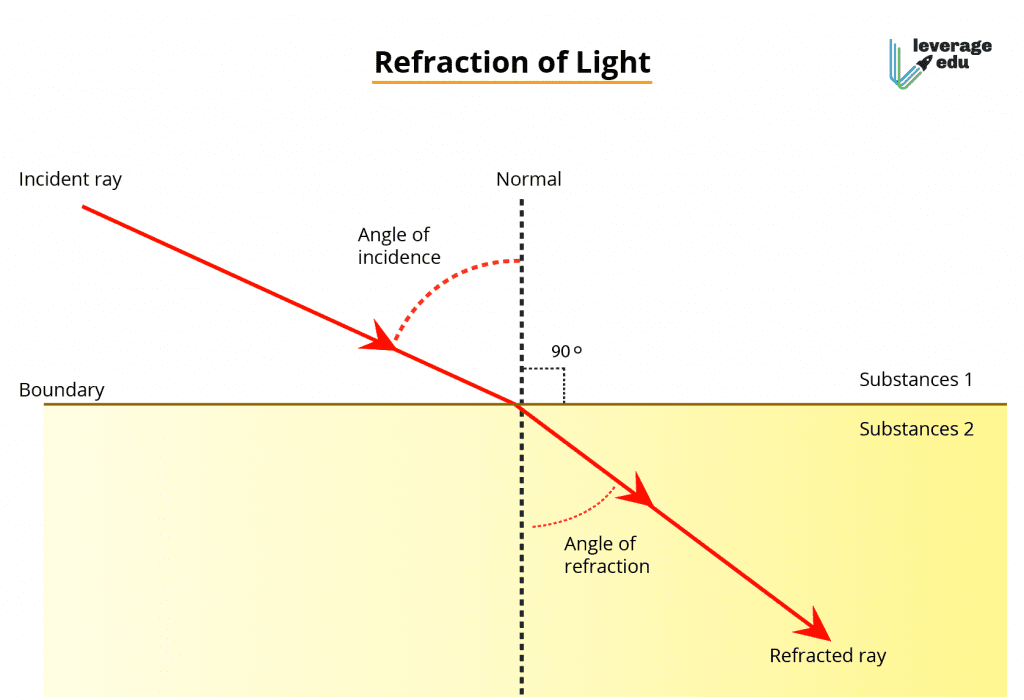
Quick Read: Reflection of Light
Key Features of Refraction
- Refraction plays a central role to form an object’s image in the lens, eye, sound, water and focal length. In Huygen’s principle, the bending of refraction can be visualized.
- In a slower medium, speed of light is reduced, the wavelength is equally shortened.
- Index of Refraction talks about how the speed of light in a medium is divided by the speed of light in a vacuum. The formula is n=c/v where ‘n’ denotes as the index of refraction, ‘c’ as the velocity of light in vacuum and ‘v’ velocity of light in the medium.
Laws of Refraction of Light
Now that we have discussed in detail the phenomenon of refraction, the next step would be to understand the two important laws of refraction-
- The reflected ray, incident ray and the normal to the interface of the two media at the point of incidence all lie on the same plane.
- The ratio of the sine of the angle of refraction to the sine of the angle of incidence is a constant. This is also known as Snell’s law of refraction.
Sin i / Sin r = Constant
What is Snell’s Law?
Snells’s law is a vital component to understand while exploring what refraction of light is. This law gives the angle of the bending ray of light on the indices of refraction of two media. This law can be derived from Fermat’s Principle or from the Fresnel Equations. The formula of Snell’s Law is n1/n2= sin θ2/ sin θ1. The ratio of the sine of the angle of incidence to the sine of the angle of refraction is constant.
Change of Speed Causes Change of Direction
Whenever light travels through a substance that has a different refractive index or optical density, there is the refraction of light. The cause behind the change in direction is the change in speed. An example would be:
- When light travels from air into water, its speed slows down, causing it to change its angle or direction, while travelling.
- The amount of bending in the refraction of light depends on two things primarily:
- The angle of the incident ray – When light enters a substance at a greater angle, the refraction of light will be much more and also be more noticeable to the human eyes. However, if the light enters a substance at a 90-degree angle to the surface, the still will not change direction but will slow down.
- Change in Speed – Whenever a substance causes the light entering it, to either speed up or slow down, the refraction of light will be more.
Refractive Index of Transparent Substances
| Substance | Refractive Index | Speed of Light in Substance (x 1,000,000 m/s) | Angle of Refraction if incident ray enters substance at 20 degrees |
| Water | 1.33 | 226 | 14.9 |
| Diamond | 2.4 | 125 | 8.2 |
| Air | 1.00 | 300 | 20 |
| Glass | 1.5 | 200 | 13.2 |
The measurement of all angles is done by drawing an imaginary line at 90 degrees to the surface of the two substances. This line is called the Normal and is drawn in a dotted manner.
Also Read: Basic Physics Formulas & Notes for Competitive Exams
Types of Refraction
- Refraction from denser to the rarer medium: In this case, the relative refractive index is less than 1 and the angle of incidence is less than the angle of refraction, that is, the refracted ray is 10 to shift away from the normal. For example: The refraction from glass to air.
- Refraction from rarer to the denser medium: In this case, the relative refractive index is greater than 1 as well as the angle of incidence is greater than the angle of refraction. Thus, the refracted ray tends to shift towards the normal. For example: Refraction of light in water from the air.
Effects & Examples of Refraction
As mentioned before, refraction can be witnessed in terms of optics as well as technology. The most common examples of refraction of light in our daily lives are:
- Stars twinkle due to refraction of their light.
- Mirage as well as looming are the optical illusions caused by refraction of light.
- Light in swimming pool refracts and gives it a shallower look when the straight light strikes it at the bottom and bends at again the water surface causing refraction of light.
- The rainbow formation as well as prism are also major examples of refraction, so is the prism.
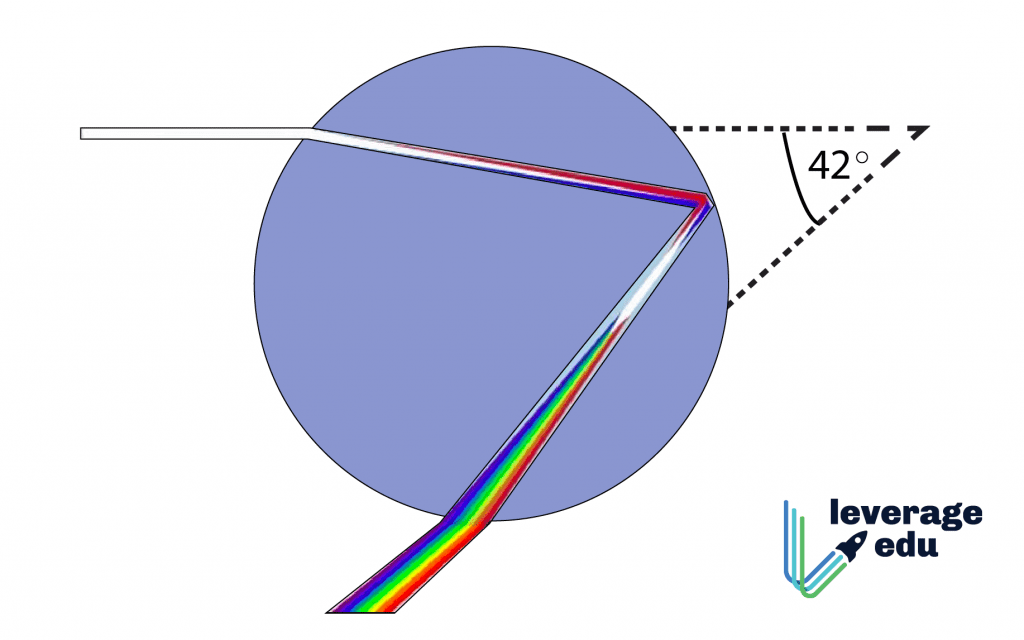
Applications of Refraction of Light
The refraction is applicable in optics as well as technology. However, it mainly depends on the type of spherical lens, be it convex or concave.
- A lens is used for refraction in order to form an image like magnification.
- Another application of refraction is VIBGYOR which is how a white light passes through a glass prism splits it into the spectrum of colours.
- The twinkling of stars, mirage is the prime example of atmospheric refraction.
Causes of Refraction of Light
The refraction of light happens when:
- The refracted ray’s frequency remains the same.
- The intensity of refracted rays is less than an incident ray due to partial reflection and absorption of light at the interface.
- In two different media, when the light crosses the boundary, the deviation of light takes place. It occurs refraction wherein the wavelength of light and its speed varies.
Examples of Refraction of Light in Real Life
To understand the phenomena of refraction of light in more detail, here are some common daily life examples-
- The formation of a rainbow is termed as one of the most perfect examples of refraction as the sun rays bend through the raindrops which ultimately result in a rainbow.
- Mirage as well as looming are the optical illusions which occur due to the phenomena of refraction of light.
- Whenever a white light passes through a glass prism it splits into seven colour components because of refraction of light.
- Whenever you felt that the swimming pool looked shallow then its actual depth, it was all because of refraction as the light coming from the bottom of the pool bends at the surface.
Refraction in Lenses
Lenses are of two kinds:
Convex
A convex lens is the type of lens that is used in making magnifying glasses. It is thicker in the middle and thinner at the edges. A convex lens is also known as a Converging Lens.
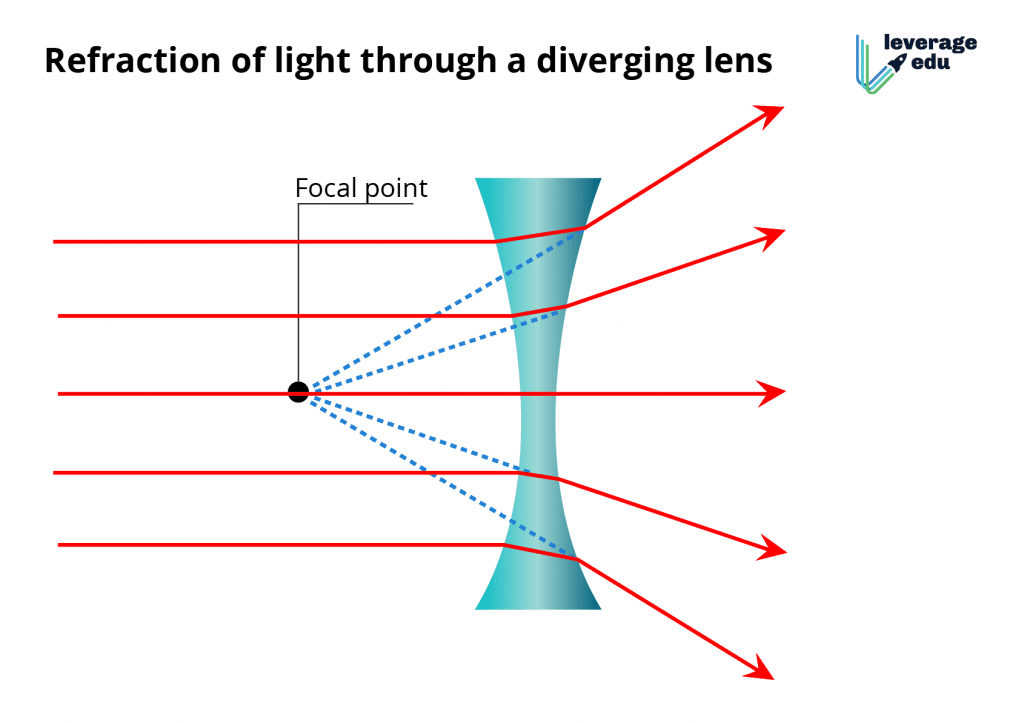
Concave
A concave lens is thinner in the middle and thicker at the edges. The refraction of light occurs outwards as it enters a concave lens and then as it leaves it too. A concave lens is known as a Diverging Lens.
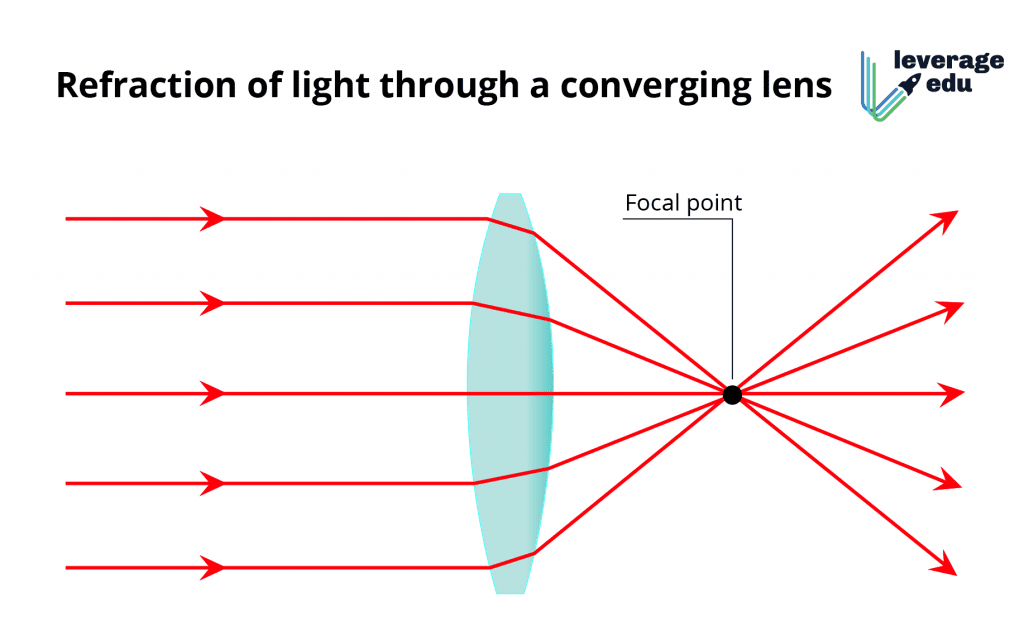
Refraction in Spectrum
This type of refraction talks about how a white light passes through a prism and results in each colour refracting at a very different angle. Violet colour is on the extreme end of this spectrum while Red at the least. Therefore, a prism can be used in order to depict the VIBGOYR colours in the spectrum.
Refraction of light in Spectrum gives evidence that white light is made up of the colours of the Rainbow. It can be easily remembered like this:
- V – Violet
- I – Indigo
- B – Blue
- G – Green
- Y – Yellow
- O – Orange
- R – Red
The explanation behind these colours breaking out when they pass through the prism is because light is made of up waves.
- Since the wavelengths of the red light and violet light are different from each other, red light having a longer wavelength as compared to violet light, their refractive index is different from each other
- The refractive index of violet light is 1.532
- The refractive index of red light is 1.513
- This slight difference is sufficient for the shorter wavelengths of light to be refracted more
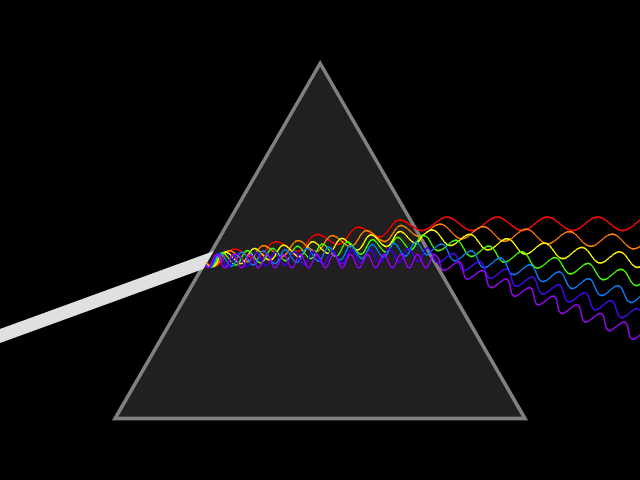
Also read: Experiment With Diverse Career in Physics
Popular Physics Books
It is necessary to have an in-depth knowledge pertaining to optics in order to understand the refraction of light. Here is the list of popular books you can read thoroughly in order to gain a better understanding on this concept:
| Name | Author | BUY HERE! |
| Manipulating Light: Reflection, Refraction, and Absorption (Exploring Science: Physical Science) | Darlene Ruth Stille | BUY HERE! |
| A System of Optics | Henry Coddington | BUY HERE! |
| Introduction to Modern Optics (Dover Books on Physics) | Grant R. Fowles | BUY HERE! |
| The Handbook of Photonics | Mool C. Gupta | BUY HERE! |
| Opticks | Sir Isaac Newton | BUY HERE! |
| Introduction to Classical and Modern Optics (4th Edition) | Jurgen R. Meyer-Arendt | BUY HERE! |
Practice Questions
After completely understanding the concept of refraction of light, now is the time to solve these questions-
- The light is travelling through an optical fibre and reaches the end of the optical fibre then exits into the air. If the angle of incidence at the end of the fibre is 45°, then, what will be the angle of refraction outside the fibre?
- A light travelling in the air enters in an optical fibre with refractive index 1.44. In which direction the light will bend? The angle of refraction at the end of the fibre is 30° what will be the angle of incidence?
- A concave lens has focal length of 20 cm. At what distance from the lens a 5 cm tall object be placed so that it forms an image at 15 cm from the lens? Also calculate the size of the image formed.
- An object 50 cm tall is placed on the principal axis of a convex lens. Its 20 cm tall image is formed on the screen placed at a distance of 10 cm from the lens. Calculate the focal length of the lens.
- If a light ray IM is incident on the surface AB as shown, identify the correct emergent ray.
- The refractive index of diamond is 2.42”. What is the meaning of this statement in relation to speed of light?
- Draw the following diagram in your answer book and show the formation of image of the object AB with the help of suitable rays.
- A ray of light, incident obliquely on a face of a rectangular glass slab placed in air, emerges from the opposite face parallel to the incident ray. State two factors on which the lateral displacement of the emergent ray depends.
- An object 2 cm in size is placed 30 cm in front of a concave mirror of focal length 15 cm. At what distance from the mirror should a screen be placed in order to obtain a sharp image? What will be the nature and the size of the image formed? Draw a ray diagram to show the formation of the image in this case.
- What is the minimum number of rays required for locating the image formed by a concave mirror for an object. Draw a ray diagram to show the formation of a virtual image by a concave mirror.
Refraction of Light PDF
Here is a PDF for you to learn this topic better-
Hence, we hope that you have gained valuable insights on the refraction of light and optics through this blog. Planning to pursue a degree in Physics but unsure about which university to choose? Sign up for an e-meeting with our Leverage Edu mentors and we will help you in finding a suitable university that aligns with your interests and preferences and equips you with the necessary knowledge and exposure to build a rewarding career in this field!
-
It is very helpful
Tq. 🙏-
Thank you! If you want to get regular updates then please sign up for our weekly newsletter!
-
-
I love this page it was very helpful
Thanks a lot 🖒🖒🖒🖒🖒🖒🖒

 One app for all your study abroad needs
One app for all your study abroad needs





















 45,000+ students realised their study abroad dream with us. Take the first step today.
45,000+ students realised their study abroad dream with us. Take the first step today.


5 comments
It is very helpful
Tq. 🙏
Thank you! If you want to get regular updates then please sign up for our weekly newsletter!
I love this page it was very helpful
Thanks a lot 🖒🖒🖒🖒🖒🖒🖒
This page was very helpful
Thanks a lot 🖒🖒🖒🖒🖒
Thank you for the comment!